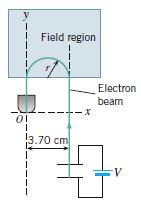Electron beams are sometimes used to melt and evaporate metals in order to deposit thin metallic films
Question:
Electron beams are sometimes used to melt and evaporate metals in order to deposit thin metallic films on surfaces (similar to gold plating). One method is to put the material to be evaporated (called the “target”) into a small tungsten cup (a crucible that has a very high melting point) and direct a beam of electrons at the target. Your team has been given the task of designing an electron-beam evaporator.
The crucible is a cylinder, 2.0 cm in diameter and 1.5 cm in height, and contains a small target of pure nickel (Ni). The electrons are accelerated through a potential difference of V = 1.20 kV, and form a beam that originates below the crucible, exactly 3.70 cm off its center, in the +x direction (see the drawing).
(a) What is the speed of the electrons in the beam?
(b) You must steer the electron beam with a magnetic field so that it curls over the lip of the cup and strikes the nickel target. Assuming that a uniform field exists above the cup (the field is zero below), what must be the radius of the beam’s circular path?
(c) In what direction should the field point if the beam initially approaches the cup from the –y axis?
(d) What must be the magnitude of the uniform magnetic field?

Step by Step Answer:

Physics
ISBN: 9781119539636
11th Edition
Authors: John D. Cutnell, Kenneth W. Johnson, David Young, Shane Stadler





